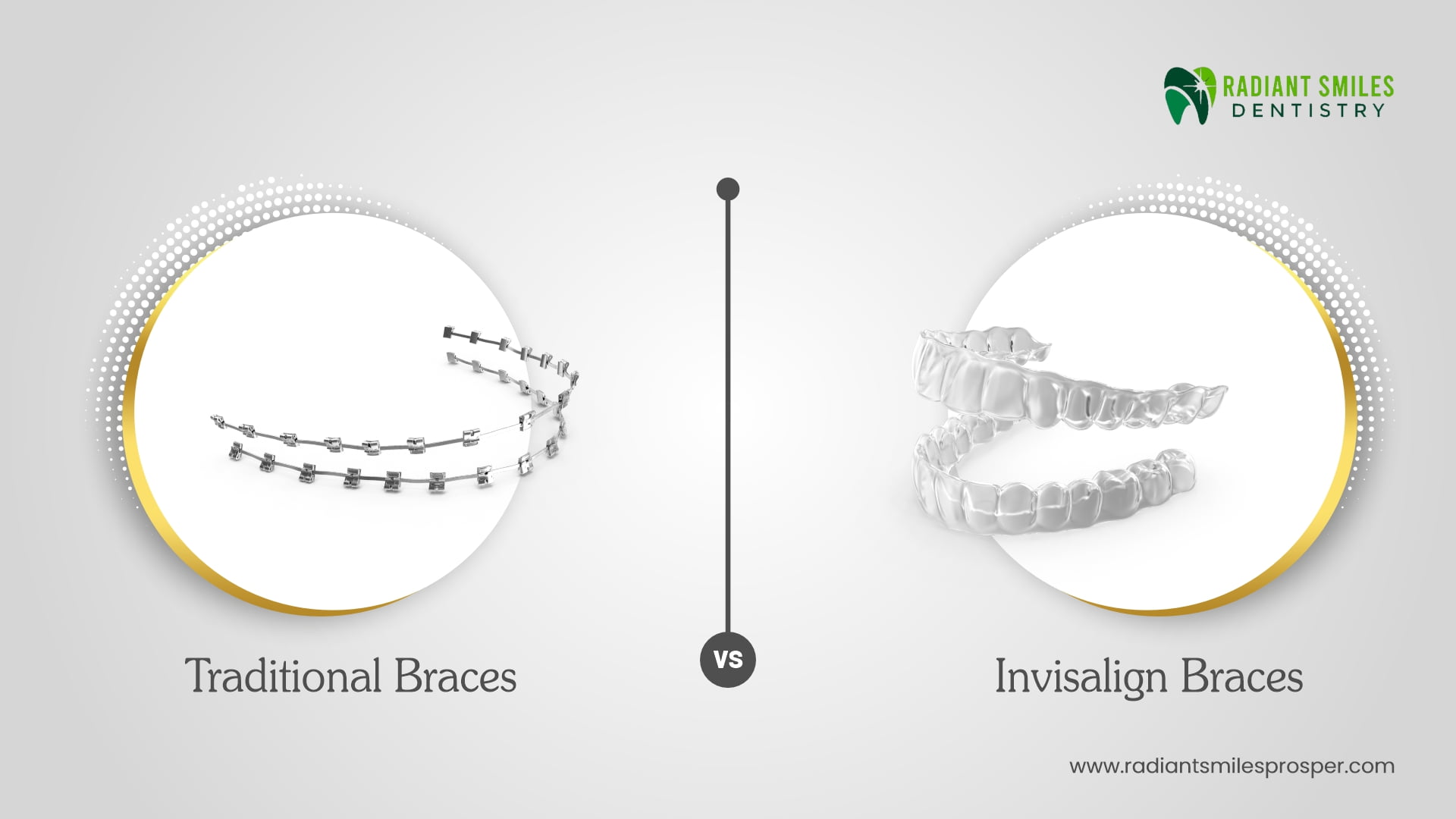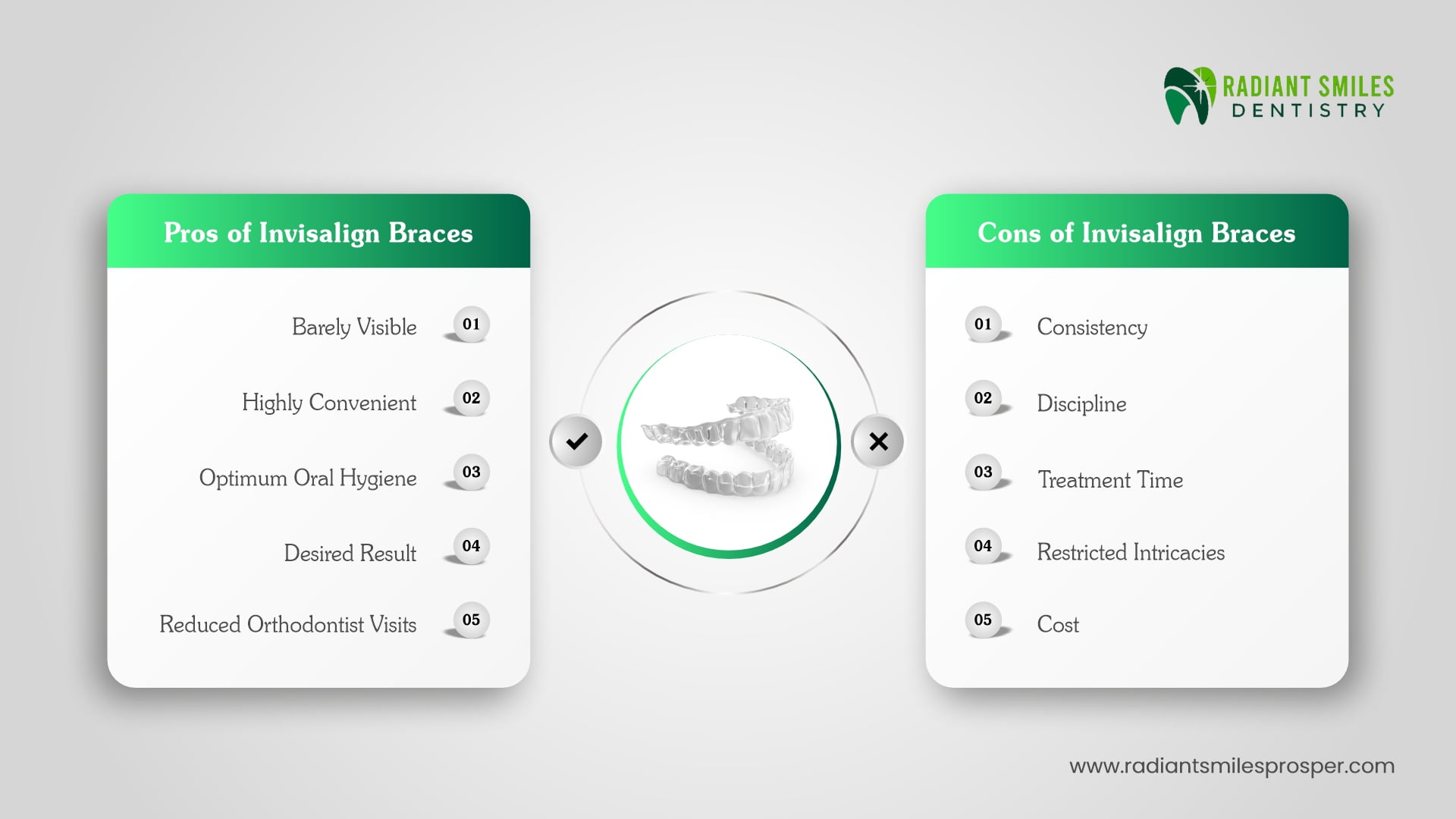Invisalign vs Traditional Braces: Comparing the Pros and Cons

Introduction
Teeth alignment issues are common across the world, with a considerable proportion of people seeking orthodontic dental treatment to correct them. According to the reports, approx. 12 million individuals across the globe initiate orthodontic treatment yearly, remembering 4,000,000 in the U.S.
The demand for orthodontic treatment has steadily increased over the years as more people understand the importance of a healthy and visually appealing smile. Factors such as inherited disposition, dental turn of events, oral proclivities, and natural components can all contribute to teeth misalignment.
Orthodontic treatment, including braces and transparent aligners like Invisalign, have become more popular options for treating tooth alignment concerns. Both the types of treatments, Invisalign and Traditional Braces are intended to address malocclusions, congestion, gaps, and other dental irregularities. Orthodontic appliances constantly guide teeth towards their ideal positions by delivering gentle pressure to the teeth over time.
Although both the orthodontic treatment, traditional braces and Invisalign are effective, it is necessary to begin with the treatment after comparing the pros and cons of Invisalign® vs Traditional Braces, which is faster and more effective for you. This comparison will assist you with settling on additional educated and precise choices for teeth alignment.
Pros and Cons of Invisalign® Braces
Pros of Invisalign:
Invisalign® is a well-known orthodontic treatment with various benefits in comparison with conventional braces. So let’s delve into the topic and understand the pros of Invisalign.
1. Barely Visible: Invisalign has a practically undetectable appearance, which is a noteworthy benefit. Because the aligners are composed of clear, translucent plastic, they are far less apparent than metal braces. As a result, many people who seek a more discrete orthodontic treatment option select Invisalign.
2. Highly Convenient: Invisalign aligners are removable, as opposed to conventional braces, which are fastened to the teeth. This feature enables you to remove your aligners when eating, drinking, or cleaning your teeth. It provides additional flexibility and convenience since you may continue ingesting your favorite meals while maintaining excellent dental hygiene.
3. Optimum Oral Hygiene: Because Invisalign aligners are detachable, you may clean and floss your teeth without difficulty. This fosters improved oral hygiene since you may keep regular brushing and flossing routines, lowering the chances of developing tooth decay and gum infection throughout the treatment.
4. Desired Result: Invisalign treatment uses contemporary computer scans to generate a personalized orthodontic regimen. This helps you to see the intended outcome while monitoring every stage of your treatment. The treatment plan is meticulously planned to progressively reposition your teeth into the right configuration, assuring consistent and effective outcomes.
5. Reduced orthodontist visits: Commonly Invisalign orthodontics involves fewer visits to the dentist than traditional braces. Adjustments and tightening are required with conventional braces, resulting in more frequent visits.
Significantly, the adequacy of Invisalign relies upon the particular orthodontic prerequisites of every individual. Decide if Invisalign is the best course of treatment for you by talking with an orthodontist or dental subject matter expert. They might assess what is happening and deal with customized answers for getting your optimal smile.
Hereby we have studied one side of the coin. Let’s flip the coin and explore the other side of the coin and understand the cons of Invisalign.
Also Read: What is Invisalign® – Benefits and How Does It Work?
Cons of Invisalign®:
While there are several noteworthy benefits to utilizing Invisalign, the drawbacks of this orthodontic treatment can not be neglected. Therefore, Let’s discuss the hindrances of Invisalign:
1. Consistency: Because Invisalign aligners are removable, you should wear them consistently for the recommended period of time every day. The inability to wear the aligners for the recommended amount of time might result in slower progress or less effective treatment results. Some people may struggle to maintain the appropriate level of responsibility and discipline.
2. Discipline: Unlike traditional braces that are fixed to the teeth, Invisalign aligners may be removed. While this provides adjustability and comfort, it also requires discipline to wear them consistently. It takes a lot to resist the need to remove the aligners on a frequent basis since this might have an impact on the treatment’s sustainability.
3. Treatment Time: In some circumstances, Invisalign treatment may take longer than traditional braces. The length of treatment varies depending on the specific orthodontic necessitated and the complexity of the case. Some people may need to wear Invisalign aligners for a longer amount of time to achieve the best results.
4. Restricted Intricacies: While Invisalign is effective for addressing a wide range of orthodontic difficulties, it may not be the best option for complicated situations or significant malocclusions. Traditional orthodontic braces provide better control over tooth growth and can cope with more complicated orthodontic situations.
5. Expected Discomfort: When Invisalign aligners are often more acceptable than traditional braces, some people may experience initial discomfort or irritation when wearing another set of aligners. This discomfort usually subsides after a few days as the teeth adjust to the new aligners.
6. Cost: When it comes to the comparison of Invisalign vs traditional braces cost, Invisalign orthodontist treatment could be costlier than conventional braces. The expense varies relying on variables like the intricacy of the case, the duration of treatment, and some other factors. While assessing the monetary part of Invisalign, taking into account your spending plan and protection coverage is necessary.
It is wise to communicate with a well-versed orthodontist or a highly qualified dentist to survey your particular orthodontic need and decide if Invisalign is the best treatment for you. They can give an intensive assessment, investigate the possible advantages and downsides, and assist you with coming to an educated conclusion about your orthodontist treatment.
As we are clear about the pros and cons of Invisalign, let us quickly jump to the pros and cons of Traditional Braces. Conventional braces have been confided in orthodontic treatment for a long time, and they accompany their own arrangement of benefits.
Key Advantages and Disadvantages of Traditional Braces:

Pros of Traditional Braces:
1. Compelling for Complex Cases: Traditional braces are profoundly powerful for rectifying a great many orthodontic issues, including serious misalignments, congestion, and chomp issues. They offer exact command over tooth development and can address complex cases that may not be appropriate for other treatment choices.
2. Treatment Control: With conventional braces, the orthodontist has full command over the changes and movement of the treatment. They can decisively apply various degrees of strain to individual teeth or gatherings of teeth, guaranteeing exact development and arrangement all through the treatment cycle.
3. No Consistency Issues: Traditional braces are fixed onto the teeth, and that implies there are no consistency issues like Invisalign. Whenever they are set, they ceaselessly pursue adjusting the teeth without the gamble of neglecting to wear or losing them.
4. Flexibility: Conventional braces can be utilized to address many orthodontic issues, from minor misalignments to additional mind-boggling cases. They are reasonable for people of any age, including kids, teens, and grown-ups.
5. Unsurprising Outcomes: Conventional braces have a long history of progress in accomplishing wanted orthodontic results. Orthodontists can precisely foresee the treatment movement and eventual outcomes in view of their experience and mastery.
6. Financially savvy: As far as cost considered, braces are in many cases more reasonably contrasted with other orthodontic treatment choices. The expense might change relying on the intricacy of the case, treatment length, and geological area. These braces can be a financially savvy answer for people looking for orthodontic treatment on a tight spending plan.
7. Accessibility: Braces are generally accessible, and numerous orthodontic practices offer this treatment choice. This openness makes it more straightforward for people to find an accomplished orthodontist who can give fundamental consideration and backing throughout the treatment interaction.
However, it’s essential to talk with an orthodontist or dental expert to decide the most reasonable treatment choice for your particular orthodontic requirements. They can assess your case, examine the expected upsides and downsides of traditional braces, and guide you towards the best treatment plan for accomplishing a sound and attractive smile.
Thereupon, let’s discuss the cons of traditional braces below.
Cons of Traditional Braces:
While conventional braces have been demonstrated to be viable in revising teeth arrangement issues, they additionally accompany a few weaknesses. Here are some cons of traditional braces to consider:
1. Constant Worries: One of the fundamental disadvantages of Traditional braces is their perceivability. The metal sections and wires are observable when you smile or talk, which might influence your certainty and confidence, especially for people who are cognizant about their appearance.
2. Inconvenience and Disturbance: Conventional braces can cause distress and aggravation, particularly during the underlying change time frame and after resulting changes. The sections and wires might rub against the delicate tissues of the mouth, prompting touchiness, ulcers, and bothering.
3. Dietary Limitations: Certain dietary limitations may apply to traditional braces. Tacky and hard food varieties can harm the supports/braces or stall out between the wires and sections, making them challenging to clean. It is important to keep away from food varieties like popcorn, biting gum, hard confections, and nuts to forestall confusion and delay the treatment term.
4. Oral Cleanliness Difficulties: Keeping up with oral cleanliness can be more difficult with conventional braces. The sections and wires make extra spaces where food particles and plaque can collect, expanding the gamble of tooth rot, gum sickness, and awful breath. Additional work and extraordinary strategies, for example, utilizing interdental brushes and floss threaders, are expected for successful cleaning.
5. Length of Treatment: Traditional braces ordinarily require a more drawn-out treatment term contrasted with a few other orthodontic choices. The specific time can differ contingent upon the intricacy of the case and the ideal result. Treatment with conventional supports might go from a while to a couple of years, requiring normal visits to the orthodontist for changes.
6. Expected Distress and Wounds: The wires and sections of traditional braces can at times cause uneasiness and minor wounds. They might jab or scratch within the mouth, prompting bruises or wounds to the lips and cheeks. Wax or dental silicone can be utilized to mitigate the distress, however, it might be an issue in any case for certain people.
7. Restricted Removability: Traditional braces are not at all removable like modern Invisalign. Whenever they are set, they stay fixed on the teeth until the treatment is finished. This absence of removability can make specific exercises, for example, playing instruments or partaking in physical games, really testing.
Therefore, talking with an orthodontist or dental expert to examine your particular orthodontic requirements and decide the most appropriate treatment choice for you is necessary. They can give definite data about the expected advantages and disadvantages of conventional supports and assist you with pursuing an educated choice in light of your oral well-being objectives and individual inclinations.
Conclusion :
As discussed, both orthodontic treatments — traditional braces vs Invisalign® — have their own pros and cons. Therefore, it’s essential to visit the best orthodontist near you for an assessment of your teeth and dental condition. They can suggest the best Invisalign treatment option based on the complexity of your dental alignment and your budget preferences.
If you are still unsure about which treatment to opt for, don’t wait any longer! Book an appointment now, and we will help you make well-informed decisions. Don’t wait till your dental misalignment causes severe dental issues to your oral health.
